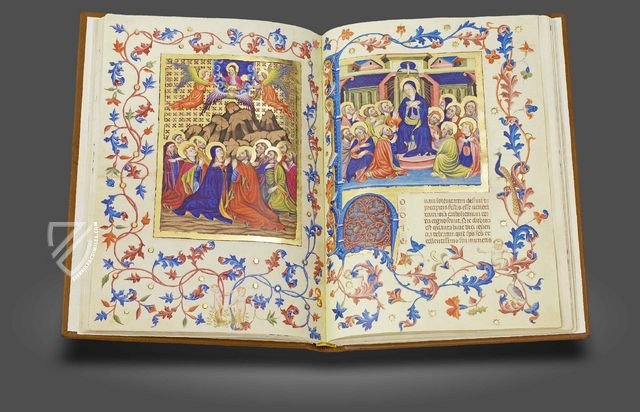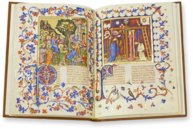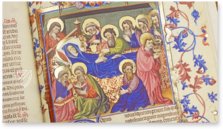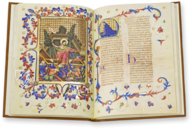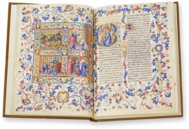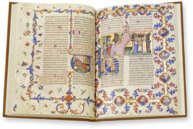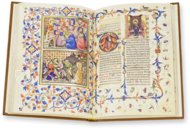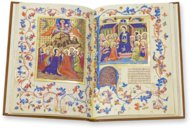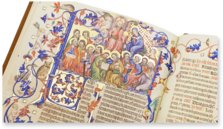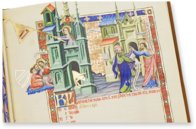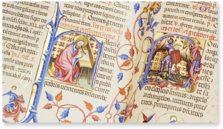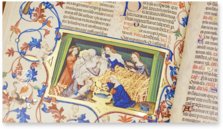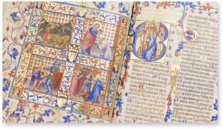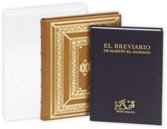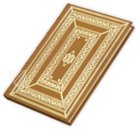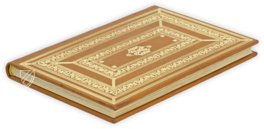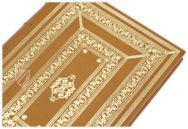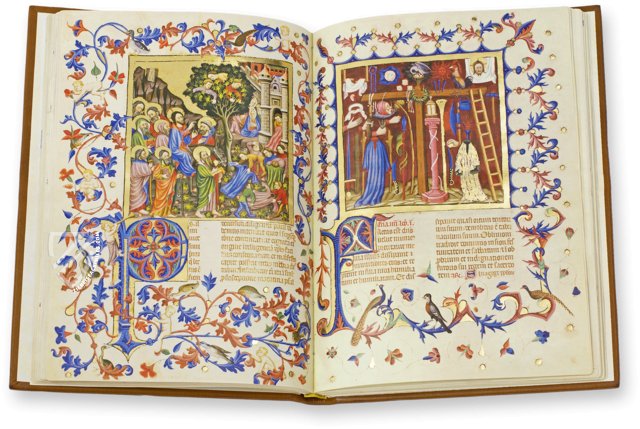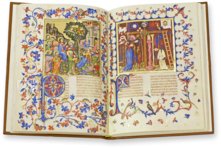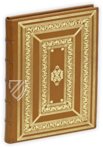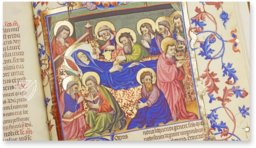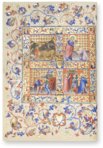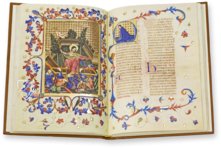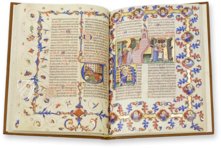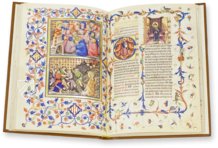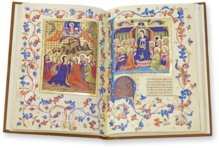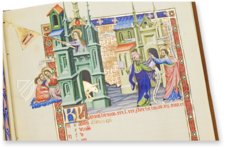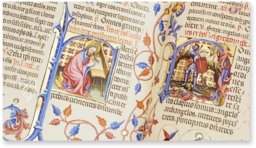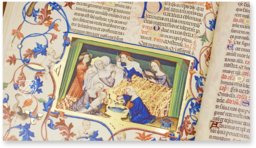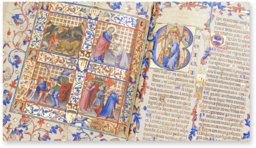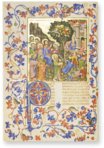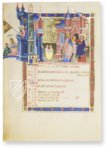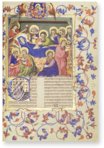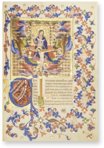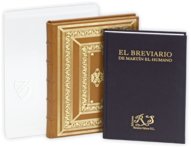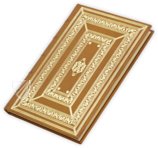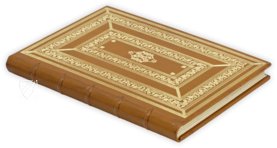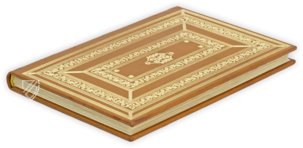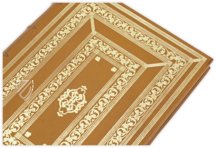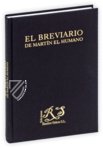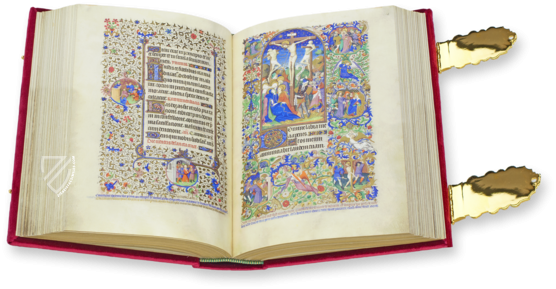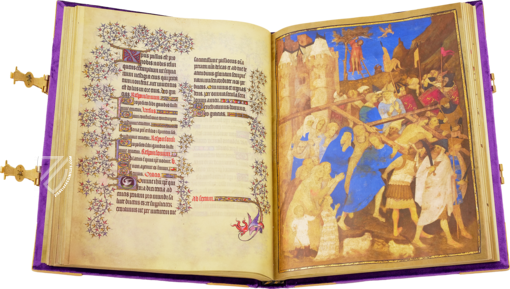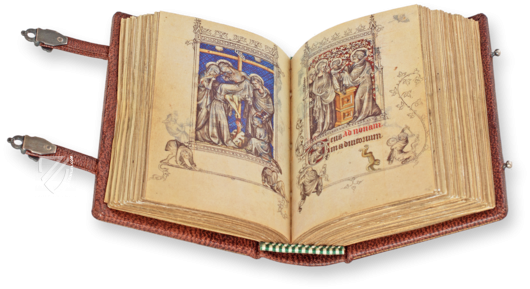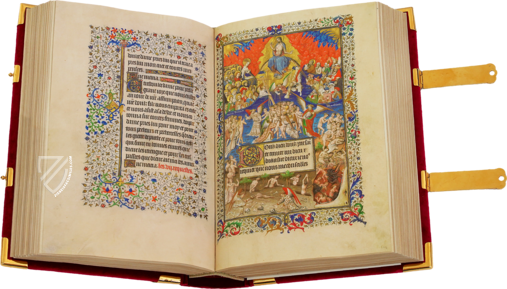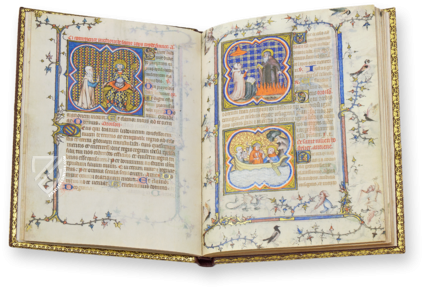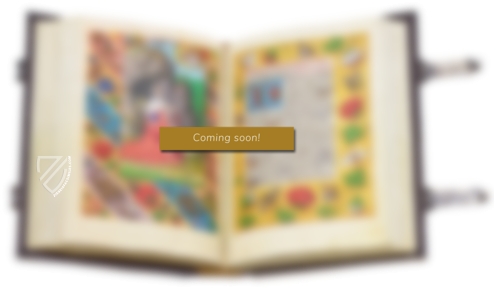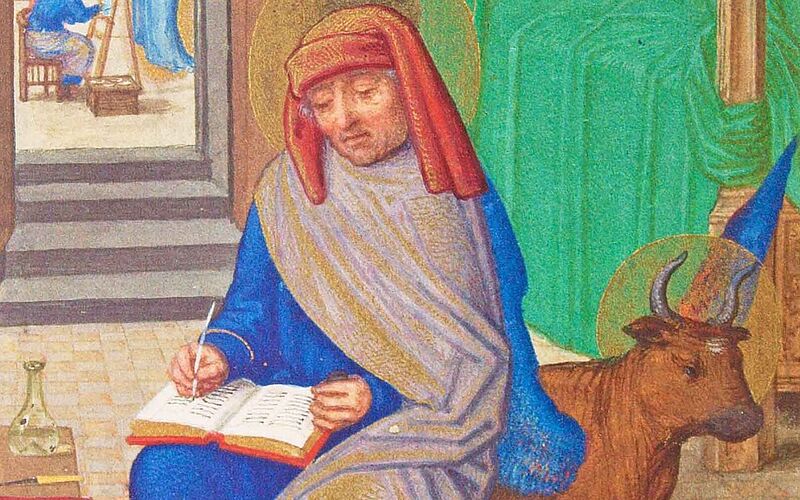Breviary of Martin of Aragon
Martin of Aragon (1356–1409), King of Aragon, Valencia, Sardinia, Corsica, Sicily, and Count of Barcelona ruled an empire that stretched across almost the entire Western Mediterranean. The magnificent Breviary of Martin of Aragon reflects the wealth and power of its royal patron with its masterful illumination, in fact, it is one of the most richly adorned Spanish Gothic manuscripts. It is also a fascinating piece of Spanish history, as it contains three letters by the king and entries on the death anniversaries of members of the royal family. Despite this grandeur and significance, or maybe because of it, most of the ownership history of the work prior to the 20th century remains shrouded in mystery to this day. Every page of the breviary is decorated with marvellous floral framings and marginalia, complemented by dozens of masterful miniatures and historiated initials with opulent gold decoration. A true highlight of Spanish Gothic book illumination!
Breviary of Martin of Aragon
One of the most densely and beautifully illuminated manuscripts of the Spanish Gothic style: the Breviary of Martin of Aragon. Commissioned by Martin of Aragon (1356–1410), King of Aragon, Valencia, Sardinia, Corsica, Sicily, and Count of Barcelona, this extraordinary manuscript reflects the wealth and power of a patron whose empire stretched across the Western Mediterranean. Work began on it in 1398 but it was not completed by the time of the King’s death, nonetheless, it is a masterpiece. After his death, the breviary passed to Alfonso V (1396–1458) the Magnanimous, who had it completed between 1420 and 1430. The manuscript seemingly disappeared in the following centuries until it reemerged in the library of Charles de Rothschild in Frankfurt am Main in the 20th century, and was bequeathed to the Bibliothèque nationale de France in 1947, where it is stored under the shelf mark MSS Rothschild 2529.
A Prayer Book Worthy of a King
A breviary is a prayer book similar to a book of hours, but more extensive and usually intended for use by the clergy during mass, while books of hours were typically used by members of the laity for private devotional use, or to follow along with the priest. Some monarchs, in order to distinguish themselves and have truly “kingly” manuscripts, commissioned breviaries for themselves. This particular text is oriented on the rite practiced at Poblet Abbey in Catalonia, where the kings of Aragon were laid to rest. It is mostly written in Latin, but the names of the months in the calendar section are written in Catalan, and there are also obituaries for members of the royal family of Aragon from the 13th and 14th centuries. These entries are written in blue ink to contrast with the red, black, and gold ink used in the rest of the calendar section. The half-page miniatures of the calendar section do not contain typical labors of the month but depict figures from church history, typically saints or biblical figures associated with the respective month. Every page of the text is framed with gorgeous tendrils of red, blue, and gold. The text is further adorned with 5 full-page miniatures, 24 half-page miniatures, 68 small miniatures, and numerous historiated initials. This splendor is contained within a gold embossed hard leather binding.
An Actively Involved Patron
The manuscript also contains three letters from the King pertaining to its creation. The first, written to the abbot of Poblet, is dated February 17th, 1398 and indicates that this is when work began, another from February 27th of the same year contains the king’s thanks for the abbot’s diligence and indicates that the King has sent a large number of parchments for the work. A letter from 1403, coincidentally dated to February 17th, asks for the illuminator to finish some important paintings for him and promises to send his own illuminator to help with work at the abbey.
Codicology
- Alternative Titles
- Brevier von Martin von Aragon
Breviario de Martín de Aragón
Breviarium secundum ordinem Cisterciencium
Bréviaire de Martin d'Aragon
Breviario del rey Martín
El Breviario de Martín el Humano - Size / Format
- 902 pages / 35.0 × 25.2 cm
- Origin
- Spain
- Date
- 1398–1410 and 1420–1430
- Epochs
- Style
- Genre
- Language
- Script
- Gothic Textura
- Illustrations
- Numerous miniatures of varying sizes (full-page, half-page, smaller), historiated initials and sumptous foliate borders
- Content
- Calendar, Psalter, Proprium de Tempore, Proprium Sanctorum
- Patron
- Martin I of Aragon, called the Humane (1356 – 1410)
- Artist / School
- Jean Pucelle
Bedford Master
Breviary of Martin of Aragon
David and Goliath; The Ark of the Covenant
A youthful David is depicted on the left preparing a second shot as Goliath, carrying a large red shield with a dragon, is reeling from the blow of the first stone. His helmet is askew and he is weak in the knees, about to fall. On the right, the Ark of the Covenant is flanked by two cherubim and carried alongside King David, who recovered the Ark from Kirjath-jearim and returned it to Jerusalem amid great rejoicing. Both scenes are presented before wonderfully patterned gold leaf backgrounds.
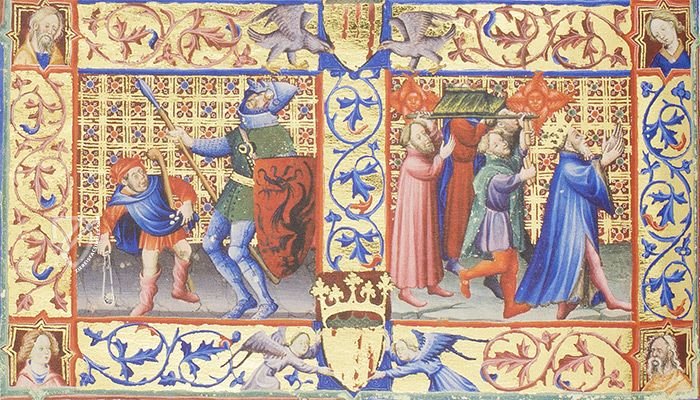
Breviary of Martin of Aragon
Entry into Jerusalem
Commemorated today on Palm Sunday, Christ’s triumphal entry into Jerusalem marks the beginning of the Passion cycle. Christ is depicted riding on a donkey, which symbolizes peace in contrast to a horse, and accompanied by a procession of his disciples proceeding on foot. The citizens of Jerusalem have come out to meet him, some lay their clothes on the ground while others climb a tree for a better look.
The figures in the scene are depicted with expressive faces, natural bodies, and are dressed in bright flowing garments. The page shines due to gold leaf in the scene’s frame, background, and halos, as well as the elaborate initial in the text. Cherubs and various birds including ducks and cranes populate the gorgeous frame of red-blue tendrils.
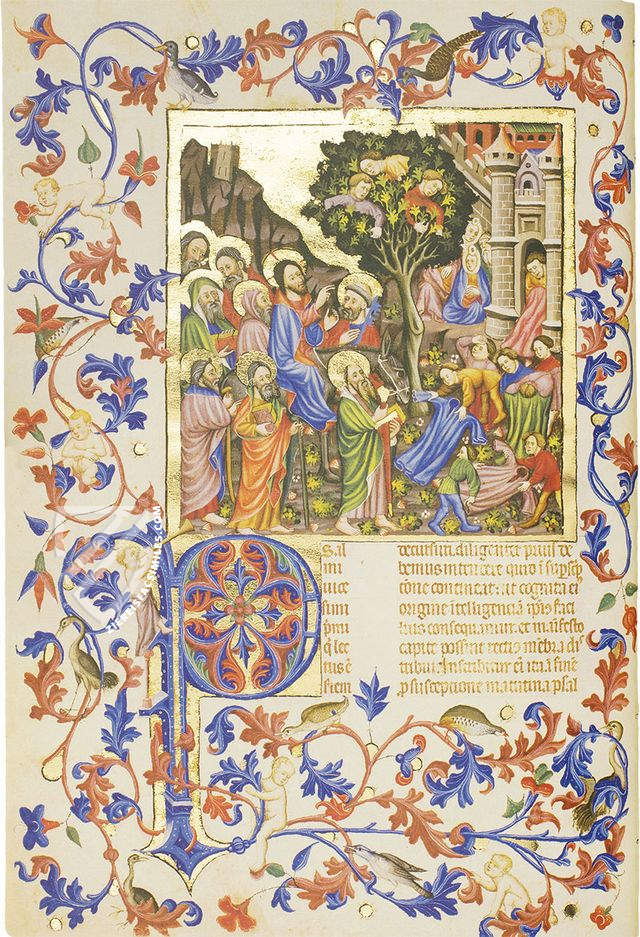
#1 Breviario de Martín de Aragón
Language: Spanish
- Treatises / Secular Books
- Apocalypses / Beatus
- Astronomy / Astrology
- Bestiaries
- Bibles / Gospels
- Chronicles / History / Law
- Geography / Maps
- Saints' Lives
- Islam / Oriental
- Judaism / Hebrew
- Single Leaf Collections
- Leonardo da Vinci
- Literature / Poetry
- Liturgical Manuscripts
- Medicine / Botany / Alchemy
- Music
- Mythology / Prophecies
- Psalters
- Other Religious Books
- Games / Hunting
- Private Devotion Books
- Other Genres
- Afghanistan
- Armenia
- Austria
- Belgium
- Belize
- Bosnia and Herzegovina
- China
- Colombia
- Costa Rica
- Croatia
- Cyprus
- Czech Republic
- Denmark
- Egypt
- El Salvador
- Ethiopia
- France
- Germany
- Greece
- Guatemala
- Honduras
- Hungary
- India
- Iran
- Iraq
- Israel
- Italy
- Japan
- Jordan
- Kazakhstan
- Kyrgyzstan
- Lebanon
- Liechtenstein
- Luxembourg
- Mexico
- Morocco
- Netherlands
- Palestine
- Panama
- Peru
- Poland
- Portugal
- Romania
- Russia
- Serbia
- Spain
- Sri Lanka
- Sweden
- Switzerland
- Syria
- Tajikistan
- Turkey
- Turkmenistan
- Ukraine
- United Kingdom
- United States
- Uzbekistan
- Vatican City
- A. Oosthoek, van Holkema & Warendorf
- Aboca Museum
- Ajuntament de Valencia
- Akademie Verlag
- Akademische Druck- u. Verlagsanstalt (ADEVA)
- Aldo Ausilio Editore - Bottega d’Erasmo
- Alecto Historical Editions
- Alkuin Verlag
- Almqvist & Wiksell
- Amilcare Pizzi
- Andreas & Andreas Verlagsbuchhandlung
- Archa 90
- Archiv Verlag
- Archivi Edizioni
- Arnold Verlag
- ARS
- Ars Magna
- ArtCodex
- AyN Ediciones
- Azimuth Editions
- Badenia Verlag
- Bärenreiter-Verlag
- Belser Verlag
- Belser Verlag / WK Wertkontor
- Benziger Verlag
- Bernardinum Wydawnictwo
- BiblioGemma
- Biblioteca Apostolica Vaticana (Vaticanstadt, Vaticanstadt)
- Bibliotheca Palatina Faksimile Verlag
- Bibliotheca Rara
- Boydell & Brewer
- Bramante Edizioni
- Bredius Genootschap
- Brepols Publishers
- British Library
- C. Weckesser
- Caixa Catalunya
- Canesi
- CAPSA, Ars Scriptoria
- Caratzas Brothers, Publishers
- Carus Verlag
- Casamassima Libri
- Centrum Cartographie Verlag GmbH
- Chavane Verlag
- Christian Brandstätter Verlag
- Circulo Cientifico
- Club Bibliófilo Versol
- Club du Livre
- CM Editores
- Collegium Graphicum
- Collezione Apocrifa Da Vinci
- Comissão Nacional para as Comemorações dos Descobrimentos Portugueses
- Coron Verlag
- Corvina
- CTHS
- D. S. Brewer
- Damon
- De Agostini/UTET
- De Nederlandsche Boekhandel
- De Schutter
- Deuschle & Stemmle
- Deutscher Verlag für Kunstwissenschaft
- DIAMM
- Droz
- E. Schreiber Graphische Kunstanstalten
- Ediciones Boreal
- Ediciones Grial
- Ediclube
- Edições Inapa
- Edilan
- Editalia
- Edition Deuschle
- Edition Georg Popp
- Edition Leipzig
- Edition Libri Illustri
- Editiones Reales Sitios S. L.
- Éditions de l'Oiseau Lyre
- Editions Medicina Rara
- Editorial Casariego
- Editorial Mintzoa
- Editrice Antenore
- Editrice Velar
- Edizioni Edison
- Egeria, S.L.
- Eikon Editores
- Electa
- Emery Walker Limited
- Enciclopèdia Catalana
- Eos-Verlag
- Ephesus Publishing
- Ernst Battenberg
- Eugrammia Press
- Extraordinary Editions
- Fackelverlag
- Facsimila Art & Edition
- Facsimile Editions Ltd.
- Facsimilia Art & Edition Ebert KG
- Faksimile Verlag
- Feuermann Verlag
- Folger Shakespeare Library
- Franco Cosimo Panini Editore
- Friedrich Wittig Verlag
- Fundación Hullera Vasco-Leonesa
- G. Braziller
- Gabriele Mazzotta Editore
- Gebr. Mann Verlag
- Gesellschaft für graphische Industrie
- Getty Research Institute
- Giovanni Domenico de Rossi
- Giunti Editore
- Graffiti
- Grafica European Center of Fine Arts
- Guido Pressler
- Guillermo Blazquez
- Gustav Kiepenheuer
- H. N. Abrams
- Harrassowitz
- Harvard University Press
- Helikon
- Hendrickson Publishers
- Henning Oppermann
- Herder Verlag
- Hes & De Graaf Publishers
- Hoepli
- Holbein-Verlag
- Houghton Library
- Hugo Schmidt Verlag
- Idion Verlag
- Il Bulino, edizioni d'arte
- ILte
- Imago
- Insel Verlag
- Insel-Verlag Anton Kippenberger
- Instituto de Estudios Altoaragoneses
- Instituto Nacional de Antropología e Historia
- Introligatornia Budnik Jerzy
- Istituto dell'Enciclopedia Italiana - Treccani
- Istituto Ellenico di Studi Bizantini e Postbizantini
- Istituto Geografico De Agostini
- Istituto Poligrafico e Zecca dello Stato
- Italarte Art Establishments
- Jan Thorbecke Verlag
- Johnson Reprint Corporation
- Josef Stocker
- Josef Stocker-Schmid
- Jugoslavija
- Karl W. Hiersemann
- Kasper Straube
- Kaydeda Ediciones
- Kindler Verlag / Coron Verlag
- Kodansha International Ltd.
- Konrad Kölbl Verlag
- Kurt Wolff Verlag
- La Liberia dello Stato
- La Linea Editrice
- La Meta Editore
- Lambert Schneider
- Landeskreditbank Baden-Württemberg
- Leo S. Olschki
- Les Incunables
- Liber Artis
- Library of Congress
- Libreria Musicale Italiana
- Lichtdruck
- Lito Immagine Editore
- Lumen Artis
- Lund Humphries
- M. Moleiro Editor
- Maison des Sciences de l'homme et de la société de Poitiers
- Manuscriptum
- Martinus Nijhoff
- Maruzen-Yushodo Co. Ltd.
- MASA
- Massada Publishers
- McGraw-Hill
- Metropolitan Museum of Art
- Militos
- Millennium Liber
- Müller & Schindler
- Nahar - Stavit
- Nahar and Steimatzky
- National Library of Wales
- Neri Pozza
- Nova Charta
- Oceanum Verlag
- Odeon
- Orbis Mediaevalis
- Orbis Pictus
- Österreichische Staatsdruckerei
- Oxford University Press
- Pageant Books
- Parzellers Buchverlag
- Patrimonio Ediciones
- Pattloch Verlag
- PIAF
- Pieper Verlag
- Plon-Nourrit et cie
- Poligrafiche Bolis
- Presses Universitaires de Strasbourg
- Prestel Verlag
- Princeton University Press
- Prisma Verlag
- Priuli & Verlucca, editori
- Pro Sport Verlag
- Propyläen Verlag
- Pytheas Books
- Quaternio Verlag Luzern
- Reales Sitios
- Recht-Verlag
- Reichert Verlag
- Reichsdruckerei
- Reprint Verlag
- Riehn & Reusch
- Roberto Vattori Editore
- Rosenkilde and Bagger
- Roxburghe Club
- Salerno Editrice
- Saltellus Press
- Sandoz
- Sarajevo Svjetlost
- Schöck ArtPrint Kft.
- Schulsinger Brothers
- Scolar Press
- Scrinium
- Scripta Maneant
- Scriptorium
- Shazar
- Siloé, arte y bibliofilia
- SISMEL - Edizioni del Galluzzo
- Sociedad Mexicana de Antropología
- Société des Bibliophiles & Iconophiles de Belgique
- Soncin Publishing
- Sorli Ediciones
- Stainer and Bell
- Studer
- Styria Verlag
- Sumptibus Pragopress
- Szegedi Tudomànyegyetem
- Taberna Libraria
- Tarshish Books
- Taschen
- Tempus Libri
- Testimonio Compañía Editorial
- Thames and Hudson
- The Clear Vue Publishing Partnership Limited
- The Facsimile Codex
- The Folio Society
- The Marquess of Normanby
- The Richard III and Yorkist History Trust
- Tip.Le.Co
- TouchArt
- TREC Publishing House
- TRI Publishing Co.
- Trident Editore
- Tuliba Collection
- Typis Regiae Officinae Polygraphicae
- Union Verlag Berlin
- Universidad de Granada
- University of California Press
- University of Chicago Press
- Urs Graf
- Vallecchi
- Van Wijnen
- VCH, Acta Humaniora
- VDI Verlag
- VEB Deutscher Verlag für Musik
- Verlag Anton Pustet / Andreas Verlag
- Verlag Bibliophile Drucke Josef Stocker
- Verlag der Münchner Drucke
- Verlag für Regionalgeschichte
- Verlag Styria
- Vicent Garcia Editores
- W. Turnowski Ltd.
- W. Turnowsky
- Waanders Printers
- Wiener Mechitharisten-Congregation (Wien, Österreich)
- Wissenschaftliche Buchgesellschaft
- Wissenschaftliche Verlagsgesellschaft
- Wydawnictwo Dolnoslaskie
- Xuntanza Editorial
- Zakład Narodowy
- Zollikofer AG

